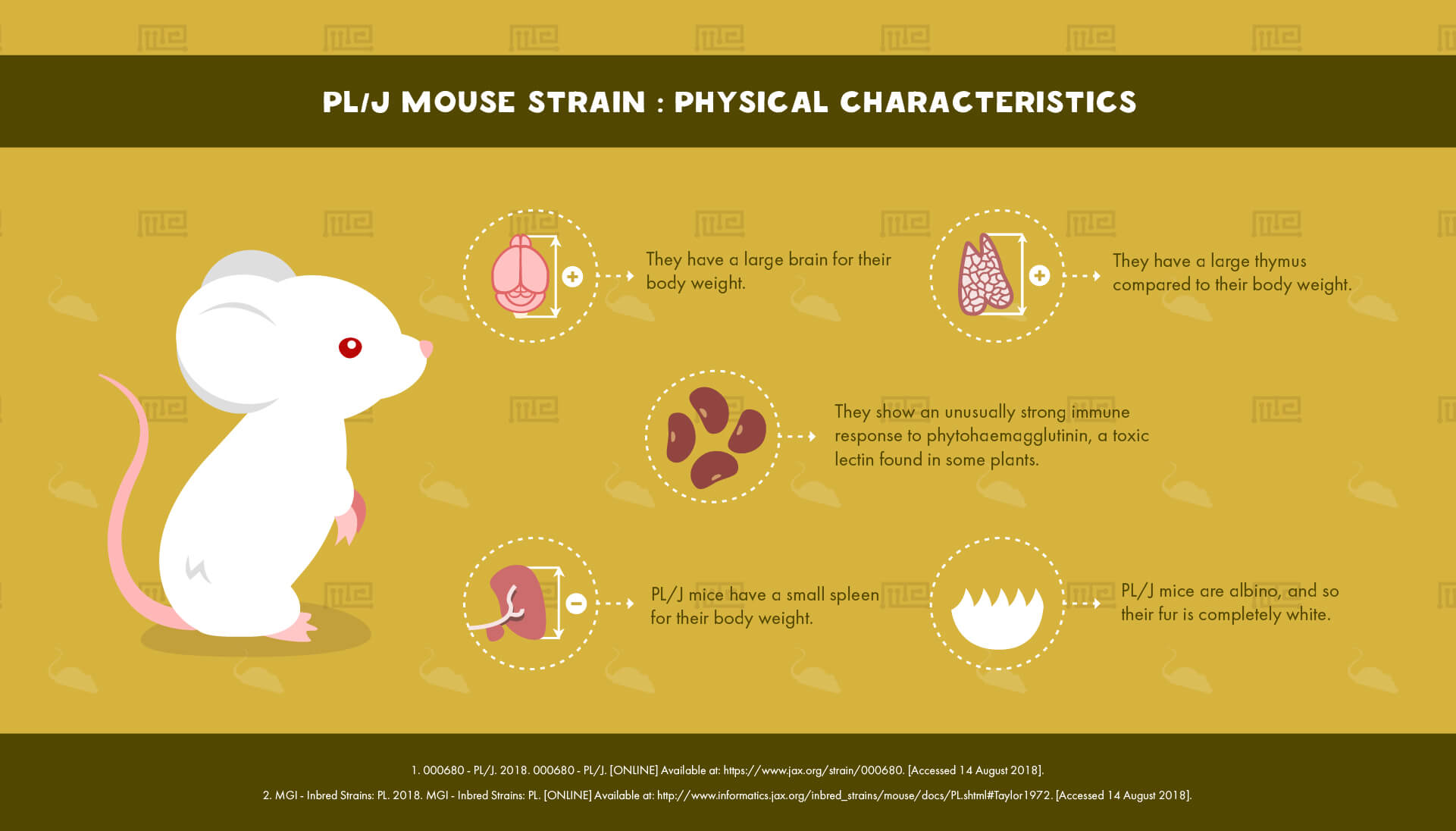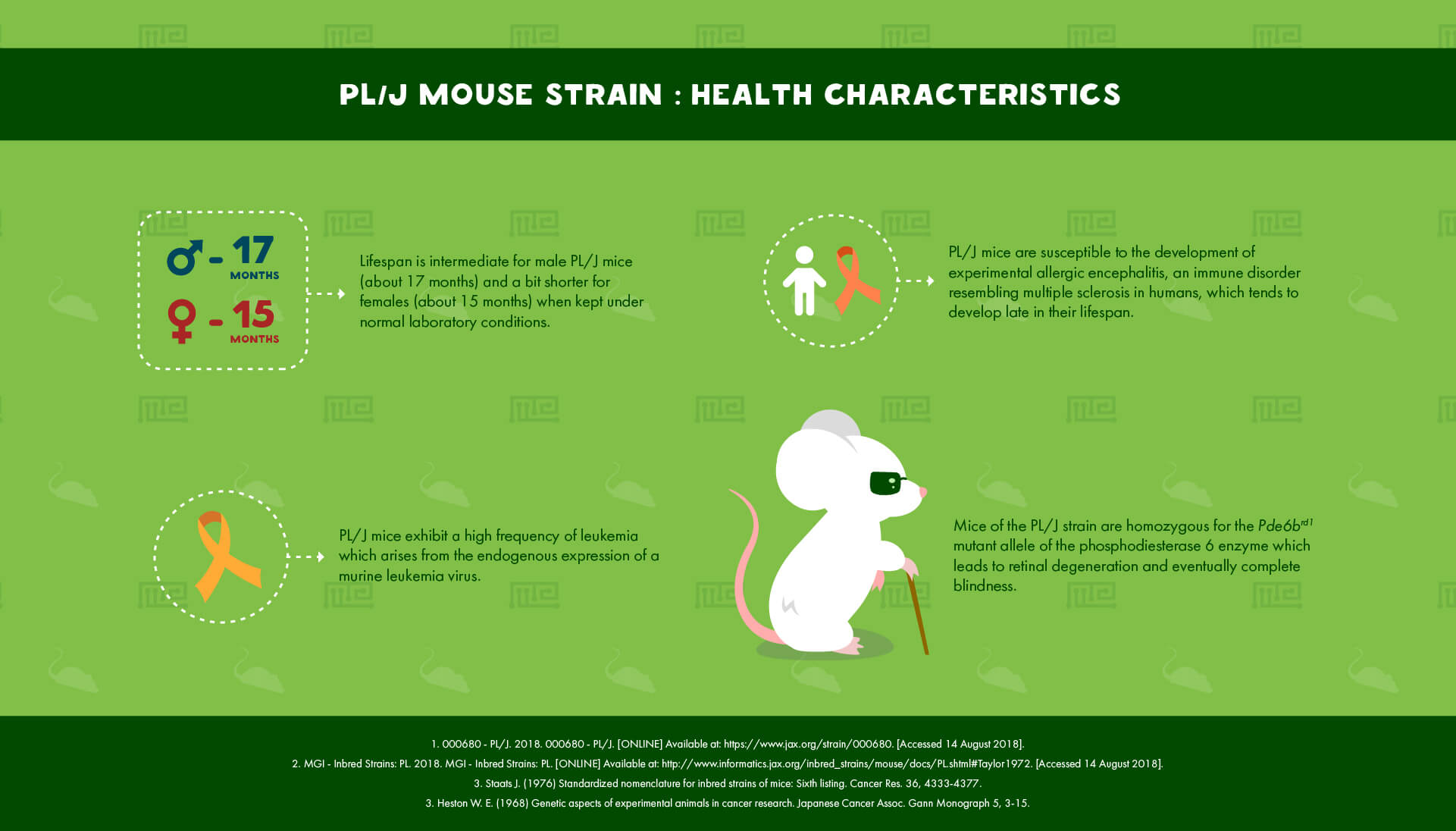Overview
PL/J is an inbred strain of mouse model that is mainly used for the study of leukemia and retinal degeneration.
History
The ancestral PL strain was developed at the Rockefeller Institute by Clara Lynch, from a non-inbred “Princeton” stock that was obtained from a dealer in 1922. Lynch developed the PL mice as a strain with a high incidence of leukemia. The mice came to the Jackson Laboratory in 1951, where the contemporary PL/J strain was created.[1][2]
Behavioral Characteristics & Handling
Researchers should exercise caution when handling this strain, as handling and rhythmic tossing of PL/J mice can easily induce seizures. Seizures in these mice can also be easily induced through electroconvulsion.[1]
Aside from this risk of seizure, PL/J mice pose few issues for a handler: a Canadian study[3] of the relative ease of handling of mouse strains reports that PL/J mice were the most placid of all 21 strains measured, showing virtually no struggling, squeaking or evasive behavior during capture and holding.
One study[4] reports that PL/J mice displayed the least anxiety of all strains tested in the elevated plus maze. These mice also had poor performance in both the Morris water maze and the T-maze, which could indicate deficits in spatial learning and memory, although the experimenters argue that the strain’s bad eyesight and propensity for seizures are the main causes of these observations.
Health Characteristics
Lifespan is intermediate for male PL/J mice (about 17 months) and a bit shorter for females (about 15 months) when kept under normal laboratory conditions.[2]
As a consequence of being developed with use as a cancer model in mind, PL/J mice exhibit a high frequency of leukemia.[1][2] Their leukemia arises from the endogenous expression of a murine leukemia virus.[5] One study reports 50% incidence of leukemia amongst female PL/J mice and only 19% amongst males,[5] but another study gives a figure of 80-90% for males.[6] The reason for this discrepancy is unclear.
PL/J mice are susceptible to the development of experimental allergic encephalitis (EAE, also known as experimental autoimmune encephalomyelitis), an immune disorder resembling multiple sclerosis in humans, where the myelin sheath is lost around neurons in the central nervous system. This condition tends to develop late in the lifespan in these mice.[1]
Mice of the PL/J strain are homozygous for the Pde6brd1 mutant allele of the phosphodiesterase 6 enzyme, leading to early onset of retinal degeneration and eventually complete blindness.[1]
Major Experimental Uses
PL/J mice have been most commonly used for research into leukemia and retinal degeneration. Their tendency to exhibit seizures has also made them of interest for epilepsy research, and their susceptibility to EAE has found them an application in research into autoimmune disorders.[1]
One paper describes EAE as a “misleading” model for multiple sclerosis in humans and claims that it is more suitable as a model for CNS neuroinflammation.[7] Another study is more ambivalent.[8] Nonetheless, murine EAE in strains such as PL/J is the most popular animal model for human demyelinating diseases.[8]
References
- 000680 – PL/J. 2018. 000680 – PL/J. [ONLINE] Available at: https://www.jax.org/strain/000680. [Accessed 14 August 2018].
- MGI – Inbred Strains: PL. 2018. MGI – Inbred Strains: PL. [ONLINE] Available at: http://www.informatics.jax.org/inbred_strains/mouse/docs/PL.shtml#Taylor1972. [Accessed 14 August 2018].
- Wahlsten, D. Metten, P. Crabbe, JC. 2003. A rating scale for the wildness and ease of handling laboratory mice: results for 21 inbred strains tested in two laboratories. Genes, Brain and Behavior. 2; 71-79.
- Sheryl S. Moy, Jessica J. Nadler, Nancy B. Young, Randal J. Nonneman, Samantha K. Segall, Gabriela M. Andrade, Jacqueline N. Crawley and Terry R. Magnusona. Social Approach and Repetitive Behavior in Eleven Inbred Mouse Strains. Behav Brain Res. 2008 Aug 5; 191(1): 118–129.
- Staats J. (1976) Standardized nomenclature for inbred strains of mice: Sixth listing. Cancer Res. 36, 4333-4377.
- Heston W. E. (1968) Genetic aspects of experimental animals in cancer research. Japanese Cancer Assoc. Gann Monograph 5, 3-15.
- Sriram S, Steiner I. Experimental allergic encephalomyelitis: a misleading model of multiple sclerosis. Ann Neurol. 2005 Dec;58(6):939-45.
- Cris S Constantinescu, Nasr Farooqi, Kate O’Brien, and Bruno Gran. Experimental autoimmune encephalomyelitis (EAE) as a model for multiple sclerosis (MS). Br J Pharmacol. 2011 Oct; 164(4): 1079–1106.


